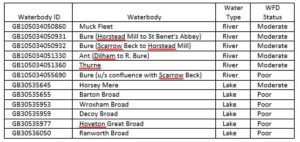What is the Water Framework Directive and how does it impact HGB?
Before we get started you can see the generic information on the Water Framework Directive (WFD) and River Basin Planning via this link. It might provide some useful context if you’re not familiar with the WFD. The DEFRA website also has some useful information here
The technical stuff
The Water Framework Directive requires the waterbodies (both surface and groundwater) of all European Union member states to achieve ‘good status’. The Directive also requires that no such waterbodies experience deterioration in status. Good status is a function of good ecological status and good chemical status, as defined by a number of quantifiable quality elements:
- Biological – fish, invertebrates, macrophytes, etc
- Hydromorphological – channel morphology, channel planform, lateral connectivity, etc
- Physio-chemical – phosphate, nitrate, dissolved oxygen, etc
- Chemical – pollutants, heavy metals, etc
The Water Framework Directive works on the one-out all-out policy, meaning that if an individual quality element is not achieving good status for a particular watercourse then the entire waterbody is classified as failing. These waterbodies are associated to catchments which link into river basins and then member states.
What this means for river managers
The Water Framework Directive empowers national regulators to manage their rivers properly and to ensure that action can be taken against those that contravene the legislation. Any works that are likely to effect a waterbody’s Water Framework Directive status will require a compliance assessment explaining how any effects will be mitigated against. With river restoration schemes the compliance assessment allows for an independent quality assurance check to make sure that the intended improvements are feasible, appropriate and will not have unexpected consequences. With other schemes the compliance assessment is intended to get applicants thinking about ecological concerns and how they can be managed.
How this impacts the Bure Catchment and the planned isolation of Hoveton Great Broad.
Anglers are well aware of the fish stocks and densities found in both the Bure and Thurne catchments, supporting some of the best natural Bream & Roach catches in competitions over recent years. These are reflected well in the EA Broads hydro-acoustic surveys which feed into the WFD fish assessment program.
Whilst we support any improvement to improve the failing of any element, it cannot be right that one waterbody GB30535977 failing for macrophytes (Water Plants), when the resultant actions contravene the legislation through the deterioration of multiple other waterbodies.




